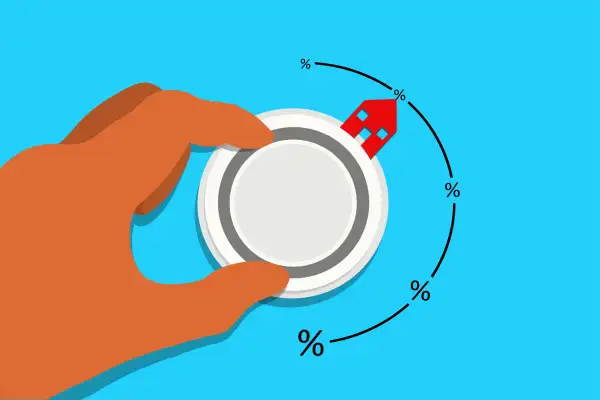Homebuyers Are Trying to Save With Adjustable-Rate Mortgages — but It Might Backfire

More homebuyers are turning to adjustable-rate mortgages as interest rates on fixed-rate loans rise. The potential short-term savings are huge — but so are the potential downsides.
As of May 20, ARMs accounted for over 9% of all mortgage applications, according to the Mortgage Bankers Association. At the start of the year, ARMs made up just 3.1% of loan applications, which is more typical.
The rush to ARMs comes as the average interest rate on the uber-popular 30-year fixed-rate loan has surged past 5%. Meanwhile, the average rate on the most common adjustable-rate loan — a 5/1 ARM — has increased at much a slower pace to around 4%.
At roughly current mortgage rates, borrowers opting for a 5/1 adjustable-rate mortgage on a median-priced home could save over $15,000 over the first five years of the loan compared to a 30-year fixed-rate mortgage, according to real estate brokerage Redfin. That’s about $260 per month.
“People are looking for more ways to expand affordability and an ARM, in certain circumstances, provides certain borrowers with that flexibility,” says Brian Rugg, chief credit officer for mortgage lender loanDepot.
In particular, Rugg points out that buyers who have been looking for a home for a while but haven’t been able to find one could counteract the loss of affordability and extend their buying power by turning to an adjustable-rate loan.
How ARMs work — then and now
Adjustable-rate mortgages have had a bad rap since the Great Recession. To see why, it helps to understand how adjustable-rate mortgages are different from their more common fixed-rate cousins.
For the first few years of an adjustable-rate loan — commonly 5, 7 or 10 years — the loan will actually have a fixed rate. After the introductory period ends, the rate will become adjustable and change at scheduled intervals — often annually or every six months — for the rest of the loan term, which typically runs 30-years total.
Back in the early-2000s, many homebuyers were enticed into ARMs by super-low ‘teaser’ rates. However, lenders didn’t cap how high the interest rate could rise once it became adjustable. When those introductory rates expired, the monthly payments increased beyond what many homeowners could afford, triggering a wave of foreclosures and sending the housing market into a tailspin. Combined with lax lending practices, this was one of the factors that caused the housing market crash of 2008.
Since then, lending standards have become much stricter and regulations now limit the maximum amount of interest that can be charged on an adjustable-rate loan. In addition to your starting rate, make sure you know the caps on your loan. These include:
- The yearly cap is often around a max of 2 percentage points above the previous rate but can be higher on the very first rate change.
- The max or lifetime cap on the loan is usually 5 percentage points above the initial rate, though some lenders will have higher caps.
If you take out a 5/1 ARM at today’s average rate, that would mean your rate could get as high as 9%. (Use an ARM calculator to determine your maximum monthly payment.) Your rate can increase or decrease multiple times during the life of the loan — although increases are more common.
“When considering an ARM, consider whether or not the loan will be affordable, and sustainable, in a fluctuating rate environment,” Rugg advises.
The pros and cons of an ARM
Just because an ARM has a lower rate does not mean it is the right choice for you. It will depend on your financial goals, notes Rugg, as “every situation is unique.” Consider both the advantages and disadvantages of adjustable-rate loans to see if they fit your goals.
The pros
Lock in a lower interest rate
The average initial interest rate on an ARM is currently more than 1 percentage point lower than the rate on a 30-year fixed-rate mortgage. Choosing an ARM means you can lock in that lower rate for a set number of years, save money on your monthly payments and lower your borrowing costs.
For example, you want a $300,000 mortgage. With a 30-year fixed-rate mortgage at a 5.30% interest rate, your monthly payments would be about $1,666. With a 5/1 ARM at 4.08%, your monthly payment would be $1,446 — but only for the first five years of the loan.
Flexible fixed-rate terms
If you know you’re only going to be staying in the home for a few years, an ARM could be a good option. You can lock in a low interest rate, which will make the monthly payments more affordable and lower your total borrowing costs.
The key, however, is to sell before the fixed-rate phase of the loan ends. If your future plans include a move to another city within the next 5-6 years, a 7/1 or 10/1 ARM will cover that period and even provide a little bit of wiggle room.
You can refinance the loan
You can monitor mortgage rate trends for signs of an increase once the adjustable-rate phase of the ARM starts. If the rate starts climbing, you have the option of refinancing to a lower-rate loan to ensure your mortgage payments stay within your budget.
The cons
The interest rate and monthly payments may increase
Taking out an ARM is a gamble on what mortgage rates will do in the future. While there is always a chance they could decrease during the adjustable rate period of your loan, the more likely scenario is that they will increase, pushing your monthly payments higher.
“The worst-case scenario is a borrower stays in a property beyond the fixed-rate term and is now at the mercy of the market regarding what the newly adjusted rate would be,” says Pat Sheehy, CEO of mortgage lender Hamilton Home Loans.
There may be prepayment penalties
Some lenders charge a prepayment fee if you pay off the loan before the full term, either through a sale, extra payments or by refinancing into another loan. This fee can increase the cost of refinancing in particular and should be taken into consideration before deciding on a refi. Ask your lender about any early payment penalties before signing off on the loan and make sure you know what the fee is. Better yet, try to choose a lender with no prepayment penalties.
You may not be able to sell or refinance
Your financial circumstance or the housing market may change after taking out an ARM. You may not be able to sell the home in the time frame you planned or you may not qualify for a lower rate loan. In either case, you may be locked into a loan with higher payments than you can afford, which could eventually lead to foreclosure.
More from Money:
The Index Used to Adjust Adjustable-Rate Mortgages Is Changing
Bubble or No Bubble? What History Tells Us About the Likelihood of a Housing Crash This Year


